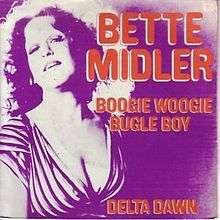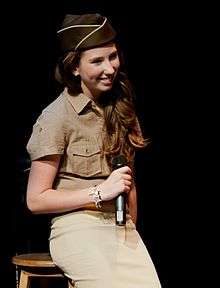Boogie Woogie Bugle Boy
| "Boogie Woogie Bugle Boy" | |
|---|---|
| Song by The Andrews Sisters | |
| Published | 1941 |
| Writer(s) | Don Raye, Hughie Prince |

"Boogie Woogie Bugle Boy" was a major hit for The Andrews Sisters and an iconic World War II tune. It can be considered an early jump blues recording. The song is ranked No. 6 on Songs of the Century. Bette Midler's 1972 recording of the song reached the top ten on the U.S. pop singles chart.
Origins of the song
The song was written by Don Raye and Hughie Prince, and was recorded at Decca's Hollywood studios on January 2, 1941, nearly a year before the United States entered World War II but after the start of a peacetime draft to expand the armed forces in anticipation of American involvement. The flip side was "Bounce Me, Brother, With a Solid Four". The Andrews Sisters introduced both songs in the Abbott and Costello film, Buck Privates (released January 1941), which was in production when they made the record. "Boogie Woogie Bugle Boy" was nominated for an Academy Award for Best Song.
The song is closely based on an earlier Raye-Prince hit, "Beat Me Daddy, Eight to the Bar," which is about a virtuoso boogie-woogie piano player.
Storyline of the song
According to the lyrics of the song, a renowned Chicago, Illinois, street musician is drafted into the U.S. Army (presumably during the peacetime draft imposed by the Roosevelt administration). In addition to being famous, the bugler was the "top man at his craft," but the army reduced his musical contributions to blowing the wake up call (Reveille) in the morning. His not being able to play his usual chops depressed him: "It really brought him down, because he couldn't jam." The Cap (An army captain — the company commander) was sympathetic and assembled a band to keep the bugler company. Back in the saddle again, he infuses his style into reveille: "He blows it eight to the bar...in boogie rhythm." His company is enthusiastic about his style too: "And now the company jumps when he plays reveille." But, apparently the bugler can't get it done without his band, "He can't blow a note if the bass and guitar/Isn't with him."
People who claim to have inspired the song
Articles published in Stars & Stripes on 19 March 1943, as well as Billboard Magazine, and The Christian Science Monitor during World War II credit Clarence Zylman of Muskegon, Michigan, as the original Boogie Woogie Bugler.[1] The lyrics in the song agree with several aspects of Zylman's life. Drafted at age 38, Clarence had been performing for 20 years, beginning with radio station WBBM in Chicago and moving on to several big bands, starting with Paul Specht and Connie Connaughton, and most recently with the Tommy Tucker Orchestra. He brought his playing style to England where he was a bugler for an engineer company, using his trumpet for Taps and Reveille, eventually being transferred to an army band. Articles in Billboard and The Plain Dealer (Cleveland, Ohio) support this, including the fact that Clarence was sent to teach other buglers his techniques.
Another claimant to the title (though he seldom mentioned it) would be Harry L. Gish, Jr. (1922–2005). At age 17, after a meteoric rise in the mid 1930s based out of the Ritz Hotel in Paducah, Kentucky, he ventured to New York City where he appeared (studio only) with the Will Bradley "All Star Orchestra" with highly regarded solos on the Raye-Prince songs "Celery Stalks at Midnight," "Scrub Me Mama With a Boogie Beat," and "The Boogilly Woogilly Piggie." He also performed with the Olsen & Johnson (of Hellzapoppin' fame) band, Ray Anthony and was popular in the Plattsburgh, New York (Lake Placid) area before returning to Decca Records in Chicago. He also had a "summer replacement" radio show there for CBS from WBBM radio.
In the 1980s and 1990s, he honored many requests to play at services for veterans' funerals, and in 1995, in the character of The Boogie Woogie Bugle Boy (still able to fit in his World War II uniform: he enlisted in the Army Air Corps) he opened the combined service units (American Legion, VFW and others) celebration of the 50th anniversary of the end of World War II in Little Rock, Arkansas, where he opened with "Reveille" and closed the ceremony with "Taps."
| "Boogie Woogie Bugle Boy" | ||||
|---|---|---|---|---|
 | ||||
| Single by Bette Midler | ||||
| from the album The Divine Miss M | ||||
| B-side | "Delta Dawn" | |||
| Released | May 1973 | |||
| Format | 7" | |||
| Genre | Pop | |||
| Length | 2:32 | |||
| Label | Atlantic Records | |||
| Writer(s) | Don Raye, Hughie Prince | |||
| Producer(s) | Barry Manilow | |||
| Bette Midler singles chronology | ||||
| ||||
Bette Midler version
Bette Midler included a cover of the song on her 1972 The Divine Miss M album, also releasing it as the B side of the album's second single, "Delta Dawn." However, when "Delta Dawn" met resistance from radio (due to competition from Helen Reddy's version), the single was quickly flipped, with "Boogie Woogie Bugle Boy" becoming the new A side. [2] Midler's version peaked at number eight on the Billboard Hot 100 singles chart in mid-1973, introducing it to a new generation of pop music fans. The single was produced by Barry Manilow. The track was also a number-one single on the Billboard easy listening chart. [3]
Chart performance
Weekly charts
|
Year-end charts
|
Other versions of the song


- In 1987, The Chipettes covered the song for the Alvin and the Chipmunks episode "Just One of the Girls."
- In 1990, pop/R&B group En Vogue did a shortened version of the song for their album Born to Sing, rewording it to sound more urban, i.e. "boogie woogie hip hop boy".
- In 1991, Marie Osmond covered the song as an inspiration for the military and as part of her USO tour for Operation Desert Shield and Operation Desert Storm.
- In 1997, the Kidsongs Kids and the Biggles covered the song for their Kidsongs video "I Can Do It!".
- In 2003, Brighton downtempo act Backini remixed a version called Company B Boy for their album Threads.
- In 2005, UK dance act Two In A Tank produced a dance version called Boogie Woogie Bugle Boy Don't Stop.
- In 2006, the Puppini Sisters recorded the song for their album Betcha Bottom Dollar.
- In 2007, R&B/Gospel group Jerry Lawson and Talk of the Town recorded the song on their album Jerry Lawson Talk of the Town.
- On their 2008 Live in Concert DVD, the von Trapp Children sang this song.
- In 2010, on VH1 Divas Salute The Troops, the song was performed by Katy Perry, Keri Hilson and Jennifer Nettles.
- In 2015, Rebecca Ferguson, Pixie Lott and Laura Wright performed the song at VE Day 70: A Party to Remember in London.[13]
- In 2015, Brazilian vocal trio Cluster Sisters recorded the song for their self-titled debut album.
Homage
- The song inspired the 1941 cartoon Boogie Woogie Bugle Boy of Company B produced by Walter Lantz Productions.[14]
- The song is referenced in the animated short Disney musical film, A Symposium on Popular Songs in the song, "The Boogie Woogie Bakery Man" written by Robert & Richard Sherman.
- The song was parodied on an early 1980s episode of Chicago-based horror movie show Son of Svengoolie as "The Boogie-Woogie Bogeyman of Berwyn".
- In the sitcom Dinosaurs, episode "Nuts to War Part 2", Earl, Roy, and Charlene dress up as USO girls and sing the song.
- In the 2nd season episode "Flaming Forties" of Mama's Family, Thelma "Mama" Harper (Vicki Lawrence), Fran Crowley (Rue McClanahan), and Naomi Harper (Dorothy Lyman) impersonate The Andrews Sisters and sing the song to entertain the classmates of Thelma's grandkids Buzz & Sonia after the band Medication that was hired failed to show up.
- In the 2nd season episode "Lucy & The Andrews Sisters" of Here's Lucy, Patty Andrews guest stars and sings a medley of Andrews Sisters hits which includes this song with Lucille Ball playing LaVerne Andrews, Lucie Arnaz playing Maxene Andrews and Desi Arnaz, Jr. playing Bing Crosby
- Christina Aguilera and Linda Perry wrote "Candyman" (released as a single in 2007) from Aguilera's hit album Back to Basics, as a tribute to the Andrews Sisters and their "Boogie Woogie Bugle Boy".[15]
- The Miami-based girl group Company B took their name from the song. They recorded their own version of the song in 1989.
- In the Sesame Street song "Dance Myself to Sleep", Ernie has Rubber Duckie play the bugle and calls him "The Boogie Woogie Bugle Duck of Sesame Street."
- On an episode of A Different World, Whitley, Kim, and Jaleesa dress up in military attire and sing "Boogie Woogie Bugle Boy" to pay homage to their friend Zelmer (played by Blair Underwood), who is about to depart for war in the Persian Gulf.
- One championship winning clip featured on ABC's America's Funniest Home Videos was entitled "Boogie Woogie Booger Boy" which is a take off on the song's name.
- Albert Ammons recorded a boogie-woogie piano elaboration of the Andrews Sisters original, released in February 1944, when the musicians' strike ended.
- The song is featured in the cafe scenes in the movie Molly: An American Girl on the Home Front.
- The Simpsons episode "Catch 'Em If You Can" features an elderly man listening to the song on a 1940s radio that he carries on his shoulder. Grampa Simpson struts along the beach in Miami as the song plays.
- An animatronic toy created by Gemmy Industries called the "Sing & Swing Bear" sung this song and danced to it.
- In March 31, 2015, the Australian female comedy trio "SketchShe", started their YouTube successful video "Mime Through Time" with a brief lip-sync performance of this song, which included choreographies, hairstyles and military costumes of the period.
- In May 2015, the movie Pitch Perfect 2 used it as reference to returning to basics and to help the "Barden Bellas" rediscover their original sound.
See also
References
- ↑ "Boogie Woogie Reveille". Billboard. Billboard (Vol 55 No. 14). 1943-04-03. Retrieved 2009-11-04.
- ↑ Hyatt, Wesley (1999). The Billboard Book of Number One Adult Contemporary Hits. New York City: Watson-Guptill Publications. p. 126. ISBN 0-8230-7693-8.
- ↑ Whitburn, Joel (2002). Top Adult Contemporary: 1961–2001. Record Research. p. 170.
- ↑ "Australian Chart Book". Austchartbook.com.au. Archived from the original on 2016-03-05. Retrieved 2016-10-08.
- ↑ "Item: 2979 - Library and Archives Canada". Bac-lac.gc.ca. Retrieved 2016-10-08.
- ↑ "flavour of new zealand - search listener". Flavourofnz.co.nz. 1973-07-09. Retrieved 2016-10-08.
- ↑ Joel Whitburn's Top Pop Singles 1955-1990 - ISBN 0-89820-089-X
- ↑ "Cash Box Top 100 7/28/73". Tropicalglen.com. 1973-07-28. Retrieved 2016-10-08.
- ↑ Steffen Hung. "Forum - Top 100 End of Year AMR Charts - 1980s (ARIA Charts: Special Occasion Charts)". Australian-charts.com. Archived from the original on 2014-10-06. Retrieved 2016-10-08.
- ↑ "Item Display - RPM - Library and Archives Canada". Collectionscanada.gc.ca. Retrieved 2016-10-08.
- ↑ "Top 100 Hits of 1973/Top 100 Songs of 1973". Musicoutfitters.com. Retrieved 2016-10-08.
- ↑ "Cash Box YE Pop Singles - 1973". Tropicalglen.com. 1973-12-29. Retrieved 2016-10-08.
- ↑ Robin de Peyer (2015-05-09). "VE Day 70th anniversary concert: Katherine Jenkins, Pixie Lott and Status Quo lead celebrations". Standard.co.uk. Retrieved 2016-10-08.
- ↑ "Boogie Woogie Bugle Boy of Company 'B' (1941)". IMDb.com. 1 September 1941.
- ↑ Moss, Corey (2007-02-21). "Xtina X Three: Aguilera Has Multiple-Personality Disorder In Clip – Music, Celebrity, Artist News". MTV. Retrieved 2012-01-04.
External links
- The Puppini Sisters' official website (featuring a sample of their version)
- Jerry Lawson's official website
- MCA Music v. Earl Wilson Columbia Law School Arthur W. Diamond Law Library Music Plagiarism Project.